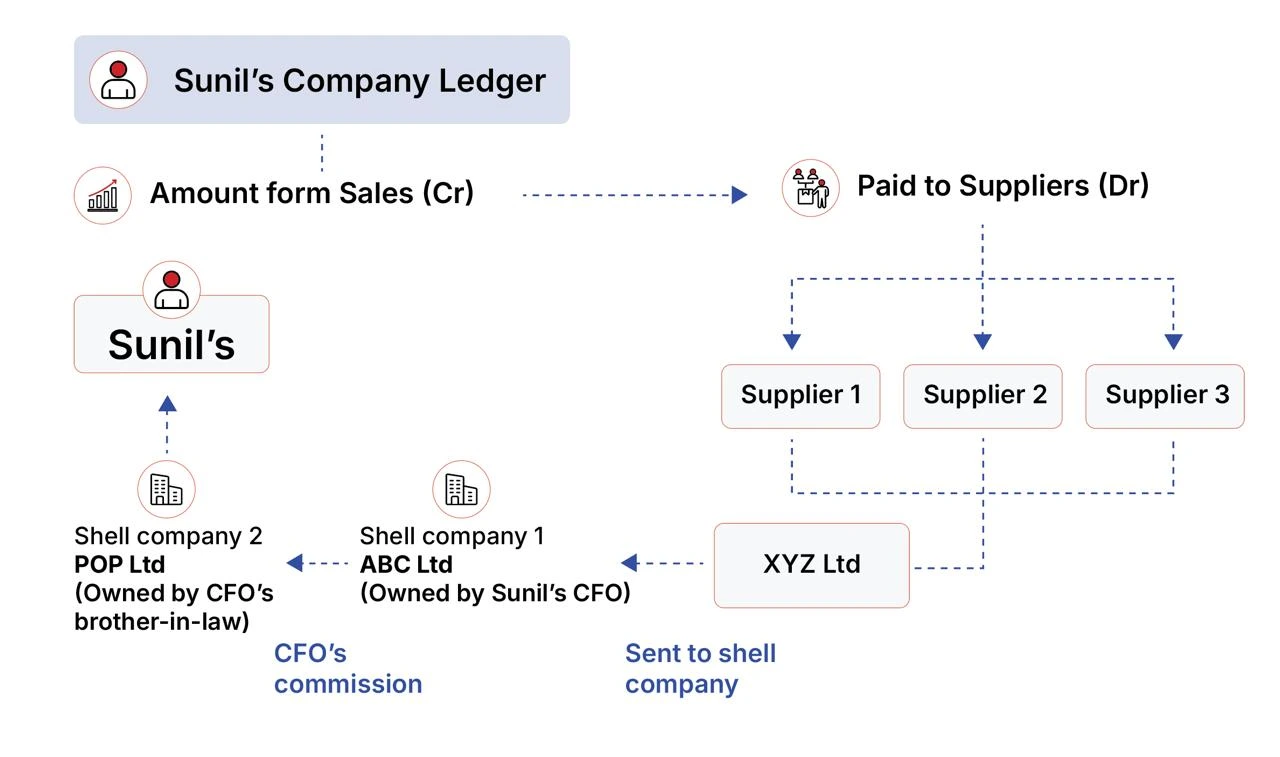Have you noticed that every time you analyze a borrower company’s ledger, it looks flawless on paper? Money flows in from customers, money flows out to suppliers.
But if you look closer, you’ll find a maze of hidden transactions - payments to fake suppliers and shell companies, all strategically set up to move money in circles until it finally lands back in the promoter’s pocket. These ledgers are engineered to appear legitimate, giving lenders a false sense of security. And no, these aren’t small frauds. We’re talking about crores vanishing into thin air every year.
RBI data shows that loan-related frauds now account for 92% of the total value lost by the Indian banking system. That’s tens of thousands of crores slipping away through corporate fraud schemes hidden in plain sight.
How do these corporate giants move such massive sums under the radar?
Let’s find out.
An example of how these frauds play out:
Consider Sunil, a mid-sized business owner. His company’s ledger shows regular payments to suppliers, including XYZ Ltd. On the surface, everything looks routine.

But look closely and you’ll see XYZ Ltd moving funds to ABC Ltd, secretly run by Sunil’s CFO Rajesh, before routing the money to his brother-in-law’s firm, POP Ltd.
Eventually, the money circles back to Sunil’s account.
But how did Sunil get away with it?
Here’s how the scheme plays out:
-
Step 1: Fake suppliers are created: These could be shell companies with no real operations. They look legitimate on paper, but exist only to move money illegally. The Ministry of Corporate Affairs has struck off 350,000+ such companies in recent years.
In Sunil’s case, both ABC Ltd and POP Ltd were ‘’vendors’’ that existed on paper, issuing fake invoices for jobs never done.
-
Step 2: Circular payments begin. Money flows through layers of entities - shell, pass-through companies, or even legitimate-looking businesses - before looping the transaction back to insiders.
-
Step 3: Books stay clean. On paper, every rupee is accounted for: invoices raised, payments made. The fraud hides in the circularity, not in missing entries.
The result?
A well-orchestrated fraud that is incredibly hard to detect.
-
Banks see suppliers being paid.
-
Auditors see compliant ledgers.
-
Regulators see filed returns.
But in reality, insiders are paying themselves. Many lenders rely on BSA to monitor ledgers for suspicious transaction trails. But BSA not only fails to work effectively - it may also be letting these fraudulent borrowers slip through the lending due diligence process.
Why can’t BSA catch such frauds?
Traditional BSA can only spot red flags in documents like audited financials, ROC filings, and loan applications. Most of these checks are one-time exercises, defined by a fixed set of rules. But detecting family-owned shell companies and insider payments through millions of transactions is like finding a needle in a haystack. Manual due diligence was never built for this scale or complexity.
Circular cash transactions, however, are designed to defeat exactly this kind of static process. Fraudsters often exploit three critical blind spots:
-
Data overload. Even a medium-sized company may process thousands of transactions monthly. Tracing each transaction to see if the trail leads back to insiders is impossible for traditional systems like BSA.
-
Hidden connections. Supplier names change slightly, ownership is masked through family members, or shell firms are registered at innocuous addresses. Without network analysis, these ties go unnoticed.
-
Static reviews. Fraud is continuous, not a one-off event. A company that appears clean at the time of loan approval can quietly build a fraud network months later. Manual checks won’t catch the shift.
That’s why frauds like DHFL’s ₹34,615 crore scam, built on 87 shell entities and circular loans, could run undetected for over a decade. Starting as early as 2006, the company’s promoters - the Wadhawan family - set up these shell firms, known as the “Bandra Book Entities.’’ DHFL then issued huge, unsecured loans to these entities, bypassing basic checks. By 2019, exposure to these shells had ballooned to ₹14,000+ crore. To hide it, management even created a fake branch and used parallel accounting systems to disguise bulk inter-corporate loans as thousands of small housing loans.
But here’s what gave it all away: Of the ₹5,662 crore sent to 39 shell firms, nearly 40% was routed back to entities controlled by the promoters. This web of layering deceived a 17-bank consortium, ultimately collapsing into a ₹34,615 crore default.
The risks of lending to the wrong businesses
The cost of ignoring this hidden fraud isn’t limited to a single default. It leaves a cascading effect on your lending system:
-
Financial losses. India’s wilful defaults now stand at ₹3.54 trillion. For every rupee lost to fraud, lenders often spend 4-5x more on legal, investigative, and recovery costs.
-
Regulatory risk. SEBI’s expanded Related-Party Transaction (RPT) rules now demand scrutiny of “purpose and effect,” not just formal relationships. Lenders that fail to uncover ultimate beneficiaries risk penalties under SEBI, RBI, or even PMLA.
-
Reputation erosion. If you are seen as a Bank/NBFC that missed an insider fraud of this scale, you may face depositor flight, higher cost of capital, and long-term brand damage. Wells Fargo’s fake accounts scandal in the US shows how reputational scars can last decades. What looks like just another loan default is, in reality, an existential risk for lenders.
Uncovering hidden transactions and their relationships doesn’t have to be guesswork, and tools like IDfy’s TIP make it possible.
IDfy’s Transaction Intelligence Platform (TIP)
Manual due diligence can’t keep pace with evolving fraud. What’s needed is a tech-driven lens on transaction data - one that doesn’t just check if money moved, but where it moved, why, and to whom it eventually flowed.
That’s where IDfy’s Transaction Intelligence Platform (TIP) steps in.
It goes beyond conventional bank statement analysis to decode the hidden ledger:
-
Network Mapping: It instantly maps the relationships between borrowers, suppliers, directors, and family members. Linking this to our previous example - Payment to “POP Ltd.” wasn’t just a supplier dues - it was a transfer to an entity linked to the borrower’s CFO’s brother-in-law.
-
Behavioral Analytics: It flags sudden spikes in payments to new suppliers, structured transactions just below reporting thresholds, or patterns inconsistent with stated business.
-
Circular Flow Detection: By tracing fund flows across multiple layers, TIP spots when money leaves a company, travels through several entities, and comes back to insiders.
-
Entity Verification: Using LLM-powered entity resolution, it detects when “XYZ Trading” and “X.Y.Z. Traders Pvt Ltd” are in fact the same shell, preventing fraudsters from hiding behind name variations.
In essence, TIP does what manual checks cannot: it pieces together the big picture from messy, fragmented data. It uses advanced Large Language Models (LLMs) trained on Indian transaction data to parse raw bank statements and answer questions like:
-
Who is the borrower really transacting with?
-
Are these counterparties secretly connected?
-
Where does each transaction trail truly end?
It doesn’t just stop at transactions. TIP layers in corporate registry data, GST filings, sanctions lists, and promoter networks to build a 360° transaction view of every entity and its hidden ties. By adopting transaction intelligence, lenders can prevent catastrophic NPAs by spotting fund signs early on and protect their reputation. TIP also creates an opportunity for lenders to distinguish legitimate businesses from fraudulent ones with precision to confidently extend more credit, faster, to the right customers. In India’s competitive lending landscape, that’s not just fraud prevention - it’s a strategic edge.
The future of smart lending is here
Every fraudulent loan begins as a clean ledger. Every siphoned rupee starts as a supplier payment.
The question for lenders is simple: Do your high-ticket borrowers really have spotless books - or are they quietly paying themselves through hidden networks?
With IDfy’s Transaction Intelligence Platform, you no longer have to guess. Are you ready to embrace the change?
